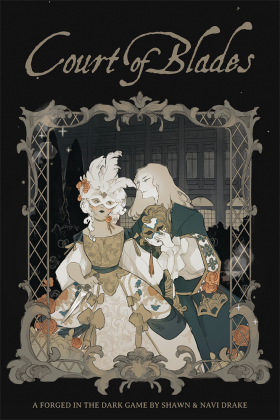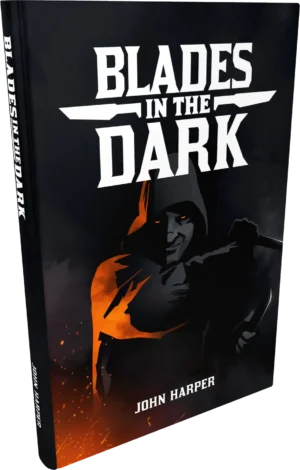Court of Blades Fantasy; Political; Narrative-Driven; Collaborative Worldbuilding; Social Intrigue; Character Customization
Court of Blades is a tabletop roleplaying game built upon the Forged in the Dark system, focusing on political intrigue, social maneuvering, and personal drama within a vibrant, fantasy renaissance setting. Players take on the roles of retainers to noble houses in the city-state of Ilrien, navigating a complex web of alliances, rivalries, and arcane secrets. While sharing core mechanics with Blades in the Dark, Court of Blades distinguishes itself through its emphasis on romance, social conflicts, and the advancement of a noble house, offering a different player experience centered on flair, panache, and the pursuit of influence rather than criminal enterprise.
Theme and Setting
Court of Blades is set in Ilrien, a vibrant city-state reminiscent of the Renaissance, steeped in political intrigue and arcane secrets. The game draws inspiration from historical warring families like the Medicis and fictional houses such as the Montagues and Capulets or the Starks and Lannisters. Players are noble retainers of a newly risen House in the Esultare, the most powerful families. The game emphasizes social conflicts, elaborate balls, manipulation, and the uncovering of rival plots. Ilrien is not presented as a dark and oppressive city like Doskvol in Blades in the Dark. It's a city of canals, gondola races, distinct districts each with unique characteristics (Luxury, Safety, Corruption, etc.), foods, holidays, and superstitions, creating a textured and customizable environment.
Core Mechanics and Rules
Court of Blades utilizes the Forged in the Dark system, a fiction-first, d6 dice pool mechanic. Actions are resolved based on Position (Controlled, Risky, Desperate) and Effect (Limited, Great), determining the consequences and impact of a character's actions. Players roll a number of dice equal to their Action rating, taking the highest result. Like Blades in the Dark, accepting a twist grants an extra die, in Court of Blades it is called The Ladyâs Favor. Characters manage Stress and Harm, with excessive stress leading to scandals. Progress on tasks is tracked using clocks, including a unique Romance Clock for pursuing relationships. While many mechanics are similar to Blades in the Dark, the game replaces Heists with Errands to gain Influence, minimizing Exposure and avoiding Scandal, which thematically shifts the focus from criminal activities to noble pursuits. Load is simplified to Discrete or Loaded.
What Makes It Unique
Court of Blades distinguishes itself through its focus on social intrigue, romance, and house advancement, contrasting with the criminal underworld theme of Blades in the Dark. The game incorporates a Paramour system and Romance Clocks to emphasize relationships and their impact on gameplay. Internal house dynamics are present, with an NPC giving assignments. The game mechanics support collaborative worldbuilding, allowing players to shape the setting through their actions. The setting provides various nationalities and leaves blank spaces to allow PCs to add details to their world. Additionally, the 'GM Turn' bookkeeping and randomized goals of the houses can make the world more unique to the game being played.
Target Audience and Player Experience
Court of Blades is aimed at players who enjoy narrative-driven games with a strong emphasis on political maneuvering and character customization. The collaborative worldbuilding aspect encourages player investment in the setting and its inhabitants. The target audience consists of groups looking for a less gritty experience compared to Blades in the Dark, favoring flair, panache, and social conflicts over criminal heists. The game is designed for campaign-length play, encouraging long-term character development and house advancement. Experienced Forged in the Dark players will find the core mechanics familiar, while newcomers will appreciate the accessible and fiction-first approach. Players who enjoy games like Game of Thrones or stories centered on courtly intrigue will likely find Court of Blades appealing.



